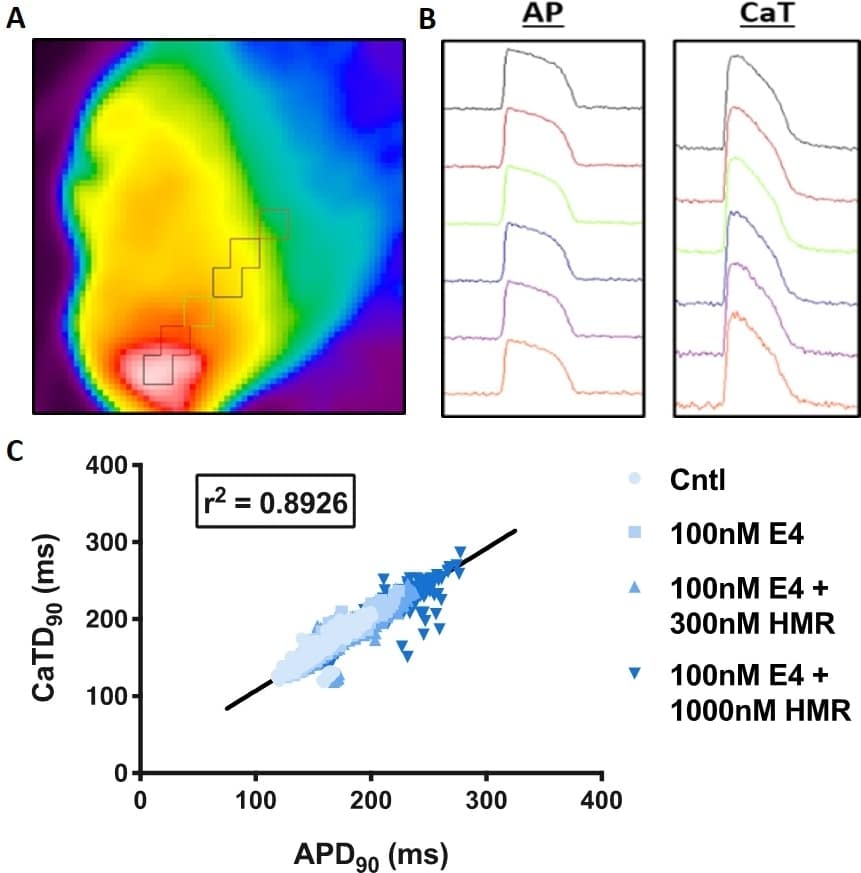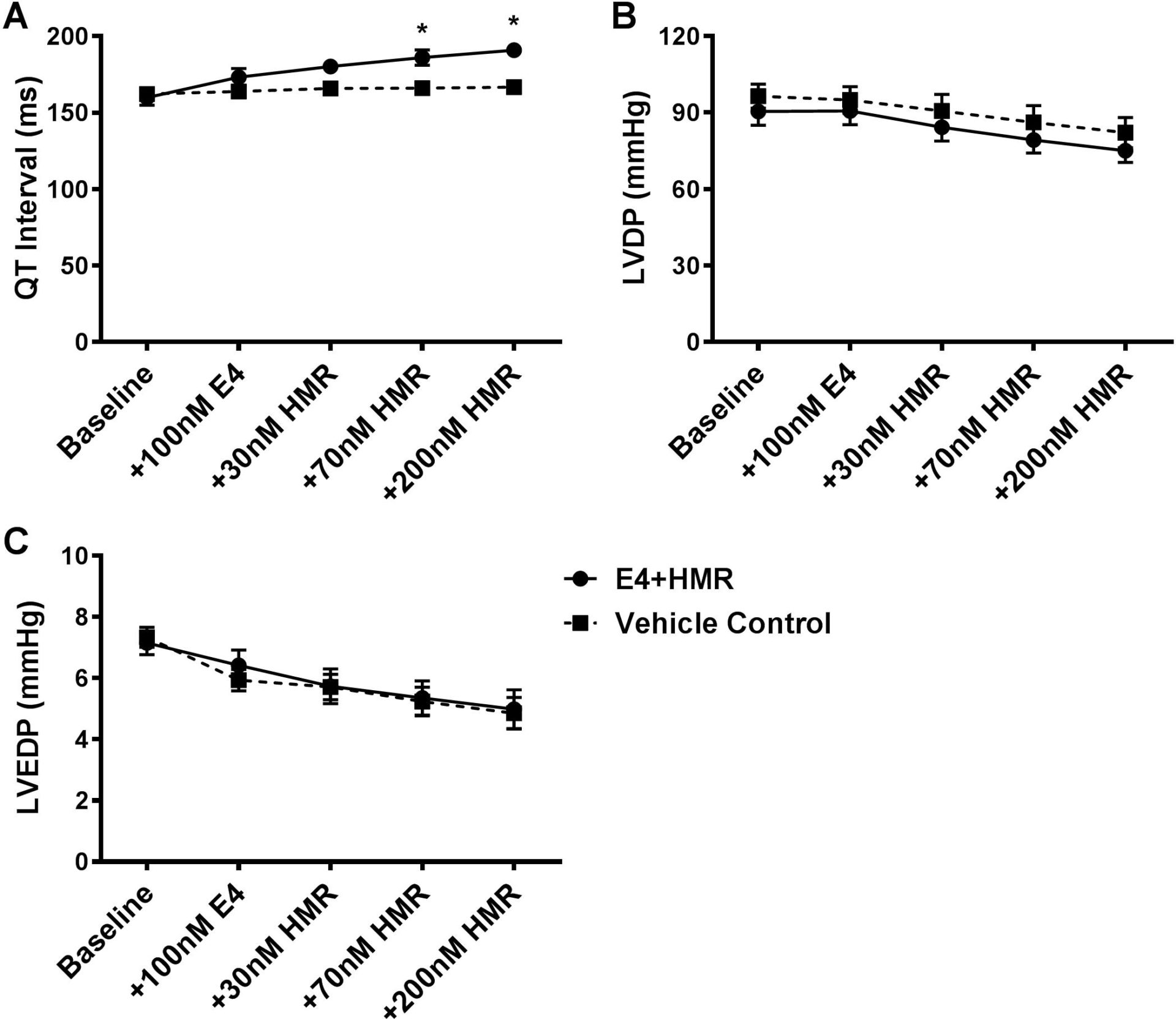Clinical studies have revealed an association between repolarisation abnormalities and diastolic dysfunction in heart failure with preserved ejection fraction (HFpEF)1-3. It is unclear whether this delayed repolarisation may directly impair active myocardial relaxation by disrupting intracellular calcium (Ca) handling. Therefore, the present study aims to characterise the relationship between action potential duration (APD/QT interval) and diastolic function. Dunkin Hartley guinea pigs (male, 500-750g) were anaesthetised (pentobarbitone, 160mg/kg, I.P.) and hearts excised and perfused with crystalloid buffer. Initial studies used optical mapping of Langendorff-perfused hearts (n=4) to demonstrate the relationship between APD and Ca transient duration. Hearts were paced at a range of cycle lengths, and incremental concentrations of E-4031 and HMR 1556 (max. 100nM E-4031 + 1000nM HMR 1556) were used to achieve pharmacological blockade of repolarising currents IKr and IKs. Voltage- and Ca-sensitive dyes (Rh237 and Rhod-2) were loaded to simultaneously record action potentials and Ca transients in the left ventricle (Fig. 1A&B). Separately, Langendorff-perfused hearts (n=6) were treated with E-4031 (100nM) and HMR 1556 (max. 300nM) or vehicle control during a paced protocol, and effects on electrophysiological and contractile activity monitored using an ECG and intraventricular balloon. Subsequently, isolated working hearts (n=6) were used to determine the effect of QT prolongation (100nM E-4031 + 30nM HMR 1556, or vehicle control) in the presence of sarco/endoplasmic reticulum Ca-ATPase (SERCA) inhibition (5µM cyclopiazonic acid). Function in the working heart preparation was monitored using a pressure-volume catheter positioned within the left ventricle. Results were analysed using two-way ANOVA with Sidak’s post hoc tests, and effects with a p value of less than 0.05 relative to control were deemed statistically significant. A strong positive correlation was demonstrated between ventricular APD and Ca transient duration (Fig. 1C). In Langendorff-perfused hearts, QT prolongation did not impair systolic or diastolic function (Fig. 2A-C). In the working heart, QT prolongation did not lead to any additional impairment of function in the presence of SERCA inhibition (Fig. 3A-F). Our data show that delaying repolarisation (prolonging APD) leads to a substantial prolongation of the cytosolic Ca transient without affecting diastolic function. This also remains true in conditions of inhibited Ca reuptake, which mimics the impairment of cellular Ca handling commonly observed in the failing heart. Thus, while APD and QT interval changes in patients with HFpEF correlate with diastolic abnormalities, the present study suggests APD prolongation does not contribute to the functional impairment of ventricular relaxation.
Physiology 2019 (Aberdeen, UK) (2019) Proc Physiol Soc 43, C017
Oral Communications: Do repolarisation abnormalities disrupt calcium handling and contribute to impaired diastolic function in heart failure?
G. C. Anderson1, J. Winter1, M. J. Shattock1
1. School of Cardiovascular Medicine and Sciences, King's College London, London, United Kingdom.
View other abstracts by:
Figure 1. Relationship between action potential duration (APD) and calcium transient duration (CaTD) in the Langendorff-perfused guinea pig heart. (A) Representative image of the left ventricle obtained using optical mapping. (B) Representative averaged action potentials and calcium transients obtained from the regions shown in (A). (C) Effect of prolonging APD by altered pacing frequency or the use of E-4031 + HMR 1556 on CaTD. (n=4).
Figure 2. Impact of QT prolongation on function in the Langendorff-perfused guinea pig heart. Effect of cumulative doses of E-4031 and HMR 1556 on (A) QT interval, (B) left ventricular developed pressure (LVDP) and (C) left ventricular end diastolic pressure (LVEDP), relative to vehicle control. Two-way ANOVA with Sidak's post hoc test, *=p<0.05. (n=6, values expressed as mean �S.E.M).
Figure 3. Impact of QT prolongation on function in the isolated working guinea pig heart in the presence of SERCA inhibition by cyclopiazonic acid (CPA). Effect of cumulative doses of E-4031 and HMR 1556 in the presence of 5�M CPA on (A) corrected QT interval, (B) left ventricular developed pressure (LVDP), (C) left ventricular end diastolic pressure (LVEDP), (D) dP/dt max, (E) dP/dt min and (F) time constant of relaxation (tau), relative to vehicle control in the presence of 5�M CPA. Two-way ANOVA with Sidak's post hoc test, *=p<0.05. (n=6 values expressed as mean �S.E.M).
Where applicable, experiments conform with Society ethical requirements.



